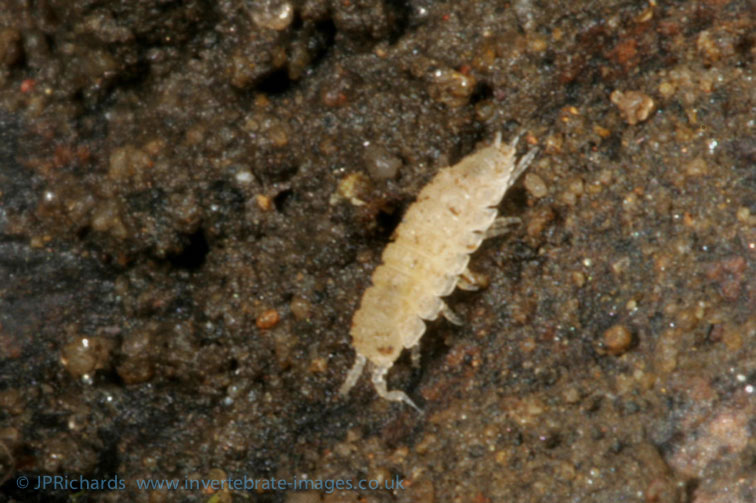Haplophthalmus montivagus Verhoeff, 1941
Common name
Status:
- GB IUCN status: Least Concern
- GB rarity status: Nationally Scarce
ID Difficulty
Identification
The pygmy woodlice of family Trichoniscidae (and Styloniscidae) are readily distinguished from other woodlice by the shape of the antennal fagellum which comprises a tapered cone (of indistinct segments) bearing a terminal bristle.
The genus Haplophthalmus is readily recognised by having distinct longitudinal dorsal ridges on the body which has a continuous body outline (all other trichoniscid woodlice have a stepped body outline) and has eyes composed of a single black ocellus.
This is a difficult genus and only male specimens of H. montivagus can be distinguished from H. mengii. Both are small species, up to 4mm in length and both, in addition to distinct longitudinal dorsal ridges, have a distinct pair of dorsal projections on the third pleonite (these are at most feebly developed in H. danicus).
The 7th pereiopod of male H. montivagus lacks the prominent spine on the carpus (present in H. mengii) and has long tapered spines on the propodus (see image right).
Distribution
This woodlouse has a scattered distribution across the chalk and limestone of southern England, but due to confusion with H. mengii, it is probably under-recorded. It has not been recorded from Ireland.
Habitat
It seems to be restricted to sites, typically ancient deciduous woodland, where friable soils have developed over limestone or chalk. However, it may be found in synanthropic sites, such as Treborth Botanic Garden, North Wales (Hughes & Hill, 2020).
Typically, it is found clinging to the underside of deeply embedded stones and dead wood, or among friable humus-rich soil and limestone rubble, often in damper spots. It is typically associated with other soil dwelling trichoniscid woodlice such as H. danicus, Trichoniscus pygmaeus and Trichoniscoides albidus.
This summary is based on the detailed account in Gregory (2009).
References
Gregory, S. (2009) Woodlice and Waterlice (Isopoda: Oniscidea & Asellota) in Britain and Ireland. Field Studies Council/Centre for Ecology & Hydrology.
Links
World List of Marine, Freshwater and Terrestrial Isopod Crustaceans: https://www.marinespecies.org/isopoda/aphia.php?p=taxdetails&id=260538






